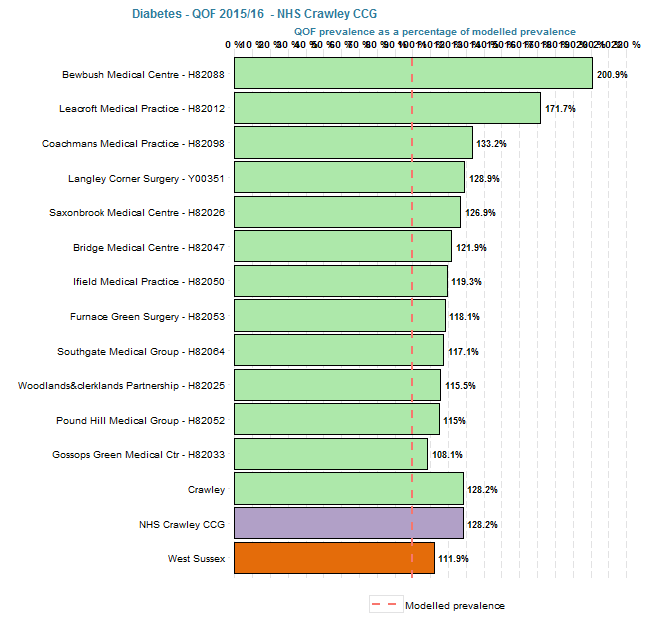Diabetes
Diabetes is a common long-term condition that causes a persons blood sugar levels to become too high. The prevalence of diabetes is a major public health challenge in England. Lifestyle changes such as exercise, weight loss and healthy eating can help to prevent or delay onset of type 2 diabetes. In addition, effective management and treatment of symptoms can help reduce the risk of common complications associated with diabetes.
The graph below shows a breakdown of QOF (Quality Outcomes Framework) information for each locality (distinguished by colour) with each bar representing an individual practice. Each bar represents the percentage of people on GP registers compared to the modelled estimates for the condition. A value below 100% suggests that fewer people registered at a GP are recorded with that condition than the modelled prevalence estimates, and a value over 100% suggests that the prevalence of people registered at a GP exceeds the modelled prevalence of people with that condition at that surgery.
Comparing the registered with the predicted prevalence provides an estimate of an unmet, or undiagnosed need within the local population. It should be noted that prevalence figures are produced by applying nationally researched assumptions to each GP practice’s population and, as such, should be treated with some caution.
The figure shows that the QOF prevalence of diabetes for most GP surgeries in Crawley CCG exceeds the modelled prevalence. This suggests that GP practices in Crawley CCG tend to have a higher prevalence of diabetes than modelled data suggests. It should be noted that modelled figures are based on nationally researched assumptions, and as such should be treated with a degree of caution.
Furthermore, the QOF register for diabetes is likely to be an underestimate of the true population with diabetes because it includes only those aged 17 years and over whilst the prevalence model includes Type 1 and Type 2 diabetes prevalence for all ages.

Data sources
- QOF: 2015/16 (published in November 2016)
- Practice Population: GP Practice Population (as at 31st March 2016)
- Prevalence Model: Yorkshire and Humber Public Health Observatory – PBS model phase 3